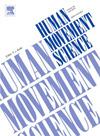Visual cue spatial context affects performance of anticipatory postural adjustments
Abstract
Past research indicates that anticipatory postural adjustment (APA) errors may be due to the incorrect selection of responses to visual stimuli. In the current study we used the Simon task as a methodological tool to challenge the response selection stage of processing by presenting visual cues with conflicting spatial context; in this case generating a step response to a left pointing arrow which appears to the participant's right side or vice versa. We expected greater mediolateral APA errors, delayed APA and step onset times, and greater lateral CoP displacement prior to stepping for visual cues with incongruent spatial contexts compared to cues with congruent. Thirteen healthy young adults completed step initiation trials (n = 40) from a force platform while whole-body kinematic motion was tracked. Participants were presented with arrows pointing to the left or right, indicating to step with the left or right limb, respectively. These arrows were presented on the same side as the desired step direction (congruent) or the opposite side (incongruent). Results revealed that incongruent trials resulted in significantly more incidences of mediolateral APA errors and greater mediolateral CoP deviations during the APA compared to congruent visual cue context trials. No effects were observed for the temporal outcomes, suggesting that young adults can maintain temporal execution of steps despite these motor control errors. This study demonstrates that the spatial context of visual information significantly impacts the success of response selection processes during step initiation, furthering our knowledge of how humans integrate visual information to initiate whole body movement.

 求助内容:
求助内容: 应助结果提醒方式:
应助结果提醒方式:


